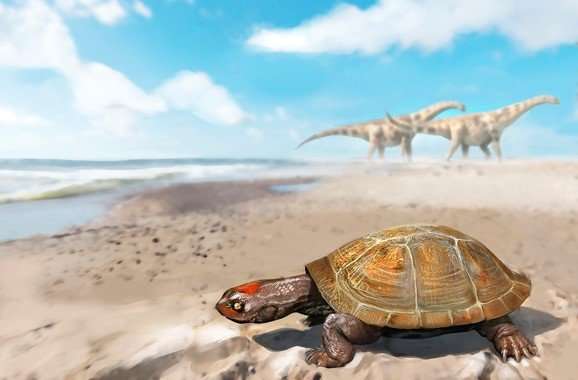The incredible journey of the first African tortoise that arrived in Europe

About 95 million years ago, a river turtle adapted to marine environments and made an extraordinary migration from the ancient continent of Gondwana, which grouped what is now Africa and South America, to Laurasia, of which the Northern continental mass of which Europe, Asia and North America were part. Species remains, found in the town of Algora in Guadalajara (Spain) and in Portugal, are evidence of the first known dispersal event of a turtle from Gondwana.
The researchers call the turtle "traveler," but the journey of Algorachelus peregrinus, as they have called it, did not start in Algora (Guadalajara-Spain), where it was recently discovered, but in Africa during the Upper Cretaceous.
"It is not just any turtle, but, as the name suggests, it gives us the necessary clues to describe how a successful migration occurred about 95 million years ago; this journey would have drastic consequences," explains Adán Pérez -García, researcher in the Evolutionary Biology Group of the UNED, the National University of Distance Education (Spain), to Sinc.
Millions of years ago, the distribution of the continents was not as we know it now. The rupture of supercontinent Pangea gave rise to two large continental masses: Gondwana -in which the current Africa and South America, among other regions- joined together, and Laurasia, which included North to Europe and North America, among others.
"This geographic isolation allowed the development of lineages of independent animals in both continental masses," says Pérez-García, the only author of the study published in the Journal of Systematic Palaeontology.From the Jurassic, the turtles were classified into two groups: Cryptodira (terrestrial, marine and freshwater) and Pleurodira (rivers and coastal environments).
The 'traveler' turtle, now extinct, belongs to the latter and its origin was African. But according to the finding, these reptiles adapted from purely freshwater environments to coastal marine environments. "That's how they moved to Laurasia, specifically to Europe, much earlier than previously considered," the paleontologist points out.
The first turtles that arrived in Europe
These turtles settled in the new continent, where they became the queens of rivers and coastal environments and became abundant and diverse until the end of the Mesozoic, about 65 million years ago. Proof of this is the identification of a skull and numerous fossils, including carapaces, in Guadalajara, which make this turtle the best represented Pleurodira of the European Mesozoic record.
In another study, published in Cretaceous Research, the discovery of other fossil remains of a shell in Nazaré (Portugal) has provided more data on this migration from Africa.
"Its discovery has allowed us to know that the faunal replacement had already begun at that time. Algorachelus corresponds to the first form of Pleurodira recognized in the continents of the northern hemisphere (Laurasia)," says Pérez-García, also the first author of this work.
According to the scientists, the journey of the turtle was a success because it did not end in Spain. Algorachelus and other turtles closely related to her continued their journey to the United States.
More information: Adán Pérez-García. A new turtle taxon (Podocnemidoidea, Bothremydidae) reveals the oldest known dispersal event of the crown Pleurodira from Gondwana to Laurasia, Journal of Systematic Palaeontology (2016). DOI: 10.1080/14772019.2016.1228549
Journal information: Journal of Systematic Palaeontology , Cretaceous Research
Provided by Plataforma SINC



















